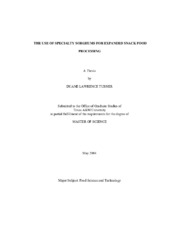| dc.description.abstract | The physical, chemical, and antioxidant properties of extrudates prepared from specialty tannin sorghum (CSC3xR28) and Tx430 black sorghums were evaluated. White food type sorghums (ATx631xRTx436) and commercial corn meal were also extruded. Sorghums were extruded as whole kernels or cracked (broken) kernels through a Maddox MX-3001 high-friction extruder. Cracked sorghum fortified with bran (0 -50%) derived from decortication or roller-milling were also extruded. Tannin sorghums extruded similarly to white food-type sorghums, with very little difference in extrudate quality. Cracking the sorghums produced lower feed rates, higher specific mechanical energy (SME) and extrudates that were less dense, more expanded, and softer than whole kernel extrudates. Whole and cracked sorghum materials had feed rates similar to corn meal, but lower SME. Corn meal extrudates were less dense, more expanded, and softer than sorghum extrudates. Cracked and whole black sorghum extrudates were less expanded than hi-tannin and white sorghum extrudates, due to the black sorghum's soft endosperm and thick, fibrous pericarp. With increased fiber, all extrudates had decreased SME and expansion, with increased bulk density and breaking force with the addition of bran. These effects, were more pronounced in extrudates containing decorticated bran vs. roller-milled bran. The decorticated bran had smaller particle size, higher density, lower endosperm content, and greater dietary fiber content than roller-milled bran. Also, increases in dietary fiber content in the extrudates were strongly correlated to increases in bran fortification in the raw feed stock. Tannin and black bran extrudates showed increased phenol, tannin (high-tannin), and antioxidants where bran was added. Phenols, tannins, and antioxidants in tannin extrudates ranged between 10.3-30.9 mg GAE/g, 7.1-55.2 CE mg/g, and 68.3-212.2 umol TE/g, respectively. Phenols and antioxidant activity in black sorghum extrudates ranged from 4.2 -7.8 mg GAE/g and 39.7 - 73.3 umol TE/g, respectively. Specialty tannin and black sorghums can be used to produce extruded snacks high in fiber and antioxidant activity. Optimum product characteristics, along with nutraceutical benefits, will need further determination. | en |


